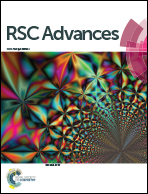Heterostructured g-C3N4/Ag/TiO2 nanocomposites for enhancing the photoelectric conversion efficiency of spiro-OMeTAD-based solid-state dye-sensitized solar cells
Abstract
In this study, solid state dye-sensitized solar cells (ss-DSSCs) were fabricated with g-C3N4 and Ag co-modified TiO2 nanoparticles as photoanode materials. Devices with spiro-OMeTAD as hole transport materials (HTMs) showed a high power conversion efficiency (PCEs) of 6.22%. For the heterostructured g-C3N4/Ag/TiO2 nanocomposites, Ag nanoparticles were deposited as an electron-conduction bridge between the TiO2 surface and the g-C3N4 layer to increase absorption in the visible-light region via surface plasmon resonance, whilst the interface between Ag/TiO2 and g-C3N4 stimulated the direct migration of photo-induced electrons from g-C3N4 to Ag/TiO2, which was conducive to suppressing the recombination of electron–hole pairs. These results show that the performance of ss-DSSCs was significantly enhanced after modification with g-C3N4 and Ag, suggesting that heterostructured g-C3N4/Ag/TiO2 composites can provide high photoelectric conversion through an effective electron transfer process.


 Please wait while we load your content...
Please wait while we load your content...